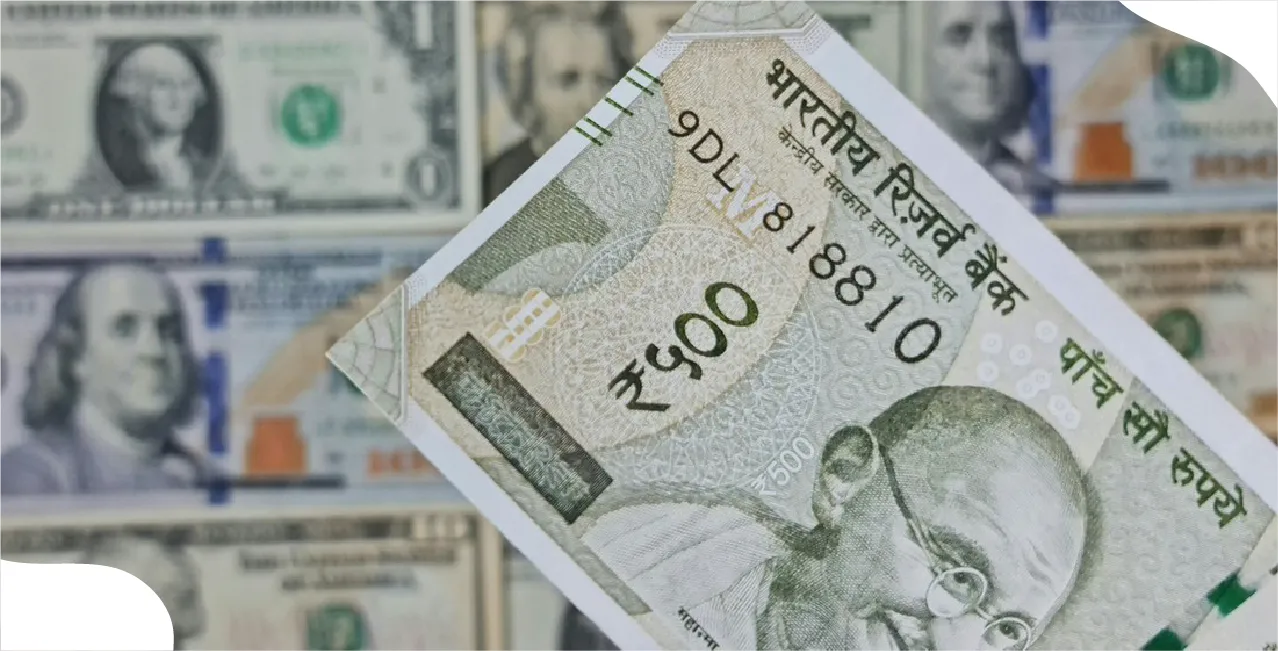
Author
LoansJagat Team
Read Time
5 Min
02 Aug 2025
Forex Reserves Rise to $698.1 Billion After $2.7 Billion Gain
India’s foreign exchange reserves climbed by USD 2.703 billion, reaching USD 698.192 billion for the week ended July 25, 2025, as reported by the Reserve Bank of India.
This restoration follows a prior decline and reflects a rebound in external asset positions.
Forex Reserves Surge by USD 2.7 Billion
In the week under review, the reserve total grew from USD 695.489 billion to USD 698.192 billion, marking a USD 2.703 billion increase. This marks a sharp reversal from the previous week’s depreciation of around USD 1.183 billion.
The rise signals a stability in India’s external reserve position after a sequence of declines. The previous dip was attributed mainly to foreign currency asset revaluations and outflows.
Subsequent inflows and valuation gains improved the buffer, giving the RBI greater flexibility in managing rupee volatility. The RBI’s weekly statistical supplement highlights such weekly swings as routine feedback from global financial markets.
Such cyclical variation demonstrates the sensitivity of reserve levels to market movements, external sector flows, and sovereign operations, notably foreign exchange interventions.
Foreign Currency Assets Lead the Gain: +USD 1.316 Billion
Foreign Currency Assets (FCA), the largest reserve component, increased by USD 1.316 billion, reaching approximately USD 588.926 billion.
This rise reflects both additional purchases of foreign bonds/deposits and positive valuation changes in other reserve currencies, namely the euro, pound, and yen. As global trade activity eases and the rupee trades within stability, FCA volumes remain sensitive to currency reval.
The RBI occasionally utilises FCA (Foreign Currency Assets) to conduct interventions: selling dollar assets during rupee strengthening phases or accumulating when rupee weakens, ensuring market orderly conditions.
Valuation channel remains significant: for instance, if the euro strengthens against the US dollar, the dollar‑value of euro‑denominated assets in the kitty rises, boosting FCA metrics even without fresh inflows.
Gold Reserves Jump by USD 1.21 Billion
Gold reserves contributed USD 1.206 billion, bringing holdings to USD 85.704 billion as of July 25.
This gain reflects both strategic bullion acquisitions and appreciating gold prices globally. The RBI’s recent purchase of nearly half a tonne of gold in June underscores its tilt toward this asset class.
Gold has emerged as the fastest-growing reserve component in recent years. The value of Gold has risen sharply in both absolute terms and as a share of total reserves. As of mid‑July 2025, gold accounted for approximately 12.1% of reserves, up from 8.9% the previous year.
This strategic shift provides a natural hedge against global economic uncertainty, inflation risks, and currency volatility, diversifying away from dollar dependency.
SDRs and IMF Reserve Position Also Rise
Special Drawing Rights (SDRs) increased by USD 126 million, taking them to USD 18.809 billion. Simultaneously, India’s reserve position with the IMF rose by USD 55 million, reaching USD 4.753 billion.
SDRs represent a claim on freely usable currencies allocated by the IMF. In contrast, the IMF reserve position is the convertible tranche available for use based on India's quota. These assets add depth and liquidity flexibility.
Although smaller in absolute terms, SDRs and IMF holdings help reinforce India’s global creditworthiness and supplement core liquidity. They remain static unless the IMF redetermines allocations or India transacts with it.
Their increase, while modest, fits within broader expectations of incremental accumulation alongside FCA and gold appreciation.
Reserve Components Breakdown
Rebound After a Three-Week Decline
India’s forex reserves had declined for three consecutive weeks prior to July 25, including a sharp USD 3.06 billion drop to USD 699.736 billion in early July and a further decline of USD 1.183 billion to USD 695.489 billion the week ending July 18.
This week’s resurgence to USD 698.192 billion signals a partial retracement of those losses, restoring market confidence.
Such swings reflect external flows, valuation shifts, and RBI forex operations, especially during periods of equity market volatility or global risk-off sentiment.
The rebound underscores the resilience of India’s external position and the central bank’s ability to steer reserves amid fluctuating conditions.
RBI’s Intervention Policy: Managing Volatility, Not Setting Targets
The RBI does not target a specific level of reserves—its intervention in forex markets is driven by the need to manage liquidity, smooth excessive rupee volatility, and ensure orderly conditions, rather than uphold any fixed reserve target.
When the rupee depreciates sharply, RBI may sell dollar assets to support the currency; conversely, if appreciation is rapid, it may accumulate. These fine-tuned operations reflect global flows rather than directional reserve accumulation.
However, consistently high reserves allow greater flexibility in managing domestic interest rates and exchange stability during external shocks. The steady rebuild enhances RBI’s toolkit in turbulent times.
Reserve management remains a balancing act: maintaining sufficient liquidity without incurring undue opportunity costs from excess idle assets, particularly in low‑yield instruments.
Supporting Inflows: FDI and FPI Trends
Besides reserve operations, cross-border capital flows have reinforced reserve levels. In April 2025, gross FDI inflows surged to USD 8.8 billion, significantly higher than USD 5.9 billion in March and USD 7.2 billion in April 2024. Close to half of these were in manufacturing and business services.
Foreign Portfolio Investments (FPI) remained robust, with net inflows of USD 1.7 billion in May 2025, supported by upbeat corporate earnings and positive global sentiment (e.g., US-China trade truce, regional ceasefire).
These inflows boost foreign exchange liquidity, ease balance of payments pressure, and support reserve build-up. Equity market gains and capital inflows reinforce the perception of India as an attractive investment destination.
Going forward, sustained FDI/FPI flows will remain critical in augmenting reserves, especially amid shifting global investor risk appetites.
Macro Context: Global Sentiment & External Sector Resilience
The recent reserve uptick occurs against a backdrop of improving global sentiment—softening trade tensions between the US and China, calming regional geopolitical dynamics, and stronger-than-expected Q4 FY25 corporate results.
These factors have improved risk appetite toward emerging markets like India, sustaining capital flows and enabling stable rupee dynamics.
At the same time, India’s merchandise and services export growth, alongside healthy remittance inflows support external sector health and reduce pressure on the balance of payments.
The combined strength of external demand, investor inflows, and strategic reserve management bolster India’s macroeconomic resilience in the face of global headwinds.
What Is Foreign Exchange and Why Countries Hold It
Foreign exchange reserves consist of financial assets denominated in foreign currencies—particularly the US dollar, along with euro, yen, pound—plus gold, SDRs, and IMF reserve positions. Managed by the central bank, they serve multiple critical functions.
Firstly, forex reserves enable a country to meet external obligations, such as paying for imports, servicing foreign debt, and handling remittances, with confidence.
Secondly, they facilitate intervention in currency markets when rupee volatility spikes. By selling reserves to support the currency, the central bank helps stabilize exchange rate swings.
Thirdly, substantial reserves instill investor confidence in India’s ability to manage external shocks. Rating agencies and global institutions view high reserves as a buffer against speculative attacks or sudden capital flight.
A real-world analogy: forex reserves are like a household’s emergency fund. When unexpected needs arise (e.g. medical bills or layoffs), having enough cash buffers helps navigate crises. Similarly, countries hold reserves to weather global shocks—like oil price spikes, sudden capital outflows, or trade disruptions.
Conclusion
India’s forex reserves rose by USD 2.703 billion to USD 698.192 billion in the week to July 25, driven by gains in foreign currency assets, gold, SDRs, and IMF claims. The rise marks a recovery from prior declines.
With supportive FDI and FPI inflows, and proactive RBI interventions, India’s external position appears solid. As gold becomes a larger portion of reserves and external inflows remain consistent, the rupee’s stability and macro-financial resilience look anchored.
Other News Pages | |||
Retail Mortgage Loans by NBFCs, HFCs to Hit ₹20 Trillion by FY28 | |||
About the Author

LoansJagat Team
‘Simplify Finance for Everyone.’ This is the common goal of our team, as we try to explain any topic with relatable examples. From personal to business finance, managing EMIs to becoming debt-free, we do extensive research on each and every parameter, so you don’t have to. Scroll up and have a look at what 15+ years of experience in the BFSI sector looks like.

Quick Apply Loan
Subscribe Now
Related Blog Post

LoansJagat Team • 10 Jun 2025

LoansJagat Team • 06 Jun 2025

LoansJagat Team • 22 Sep 2025